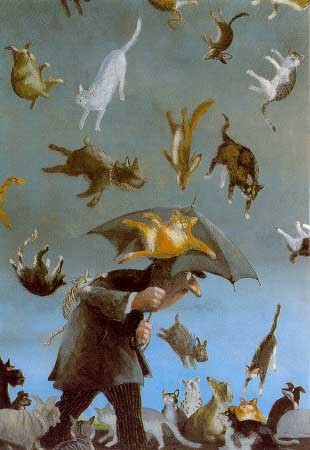(Side note: I'm talking about land-based animals falling from the sky here, not birds and bats and other flying animals. Quite frankly, I'm not entirely sure how they get up there in the first place, nor how they continue to stay up, and I'm mostly surprised that it isn't raining birds all day, every day. No, this is about animals you wouldn't expect to see falling from the sky.)
Since almost the dawn of time, until this very year, there have been numerous reports of animals appearing from nowhere (or the sky) landing all over everything and generally making a huge, bloody mess (apart from the frogs which seem to be quite good at landing). There have been a number of reports of fish and amphibian rain, but also spider, worm and cow rain. My sources didn't actually reveal any instances of cat or dog rain, though clearly this informed the English lexicon and must have been a common occurrence around the time of English's invention.
(Another side note: each nationality has its own way of describing heavy rain. For instance, the Czechs say 'wheelbarrows' on account of their love of gardening, the Danish say 'shoemaker's apprentice' because... they like shoes, and the Norwegians say 'she-trolls' because they hate women. The warmongering history of many countries is evident in their idiomatic description of heavy rain as 'a stream of mallets' (India), 'pen knives' (Portugal) and 'axes' (Serbia). It makes you realise how good the English have it, and how sturdy umbrellas must be in some countries. Only the Flemish and Germans have cuter idioms, with 'kittens' and 'young dogs' respectively used to describe heavy/historical rain. But I digress.)
So why does it rain animals? Is it water funnels/tornados sucking animals up into the weather system? Is it God, blighting humanity with nuisance plagues? Is it evil shapeshifting sheep? Who can say? After years of actual scientific study, we are no closer to finding the answers. But it's definitely not the funnels or God. There is one man, one quiet, lovely inventor/author who may have found the answer, and hidden it deep within a children's book. A man named Roald Dahl.
Ever heard of James and the Giant Peach?
In this book, some giant insects use the string generated by a spider and a silk worm to hook a number of birds to a giant fruit, in order to help them fly it. Now, realistically, giant insects and spiders are more likely to eat birds than use them to pilot stone fruit, due to their lack of actual intelligence, but the science is sound. Mine and Dahl's theory goes like this:
What if, for personal reasons, a group of animals, let's say jellyfish, decide to 'fly the coop', so to speak. Well how are they going to do it? Well they can't very well swim away (because of the personal reasons, which likely vary from species to species but might, for instance, involve a surly farmer), so they enlist the help of nearby flocks of birds. They're saved! Except they forget that birds are stupid, due to their small brains - a load-shucking necessity for flight - and at about the exact same time, they all drop their cargo. Cut to a big stinking mess, which may or may not coincide with a storm. And the phenomenon of animal rain is explained.
CASE CLOSED
PS. As a sneak bonus, below are unlettered excerpts from the graphic novelisation of my forthcoming novel, It's Raining Cats... and Nothing Else. It's based on a true story, probably.





No comments:
Post a Comment